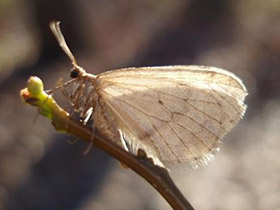 In all moths, the blood flows in a single vein from the abdomen to the thorax, and from there to the head, where it is warmed. On its return, it is filtered through tissue. In addition, the anatomy of the winter moth is different from that of summer-flying moths—a difference in design that lets the winter moth survive cold temperatures.
In all moths, the blood flows in a single vein from the abdomen to the thorax, and from there to the head, where it is warmed. On its return, it is filtered through tissue. In addition, the anatomy of the winter moth is different from that of summer-flying moths—a difference in design that lets the winter moth survive cold temperatures.
The veins extending along the winter moth's abdomen form the heart-and-aorta section of the circulatory system. This part, which extends in the upper part of the tail, turns a 90 degree angle downwards as it nears the heart region. It then enters this area from underneath where the thorax joins the abdomen. So far, the blood in this area is cold.
When the vein enters the abdomen, contraction of the muscles there warms the blood on its way from the stomach to the chest region. Where the abdomen and thorax meet, the vein assumes more or less a V shape. The blood in the left arm of the V is cold, and that in the right arm warmer.
Under normal conditions, the heat of the warm blood rising in the right arm should pass to the tail area where the cold blood circulates. However, the winter moth is never exposed to such a lethal situation— thanks to its hearing organ, in the exact center of the bend in the V. This organ is one of the examples of the superior design in the heating system. The animal's auditory organ is inside the tympanic air sacs, which function as perfect heat insulators. One can compare the sacs to a double-glazed window. The sacs prevent the passage of heat between the external and internal environment, forming a kind of barrier between the warm thorax area and the cold abdomen.
In conclusion, the tail area cannot leach heat from the stomach area. In addition, the air sacs in the abdomen provide supplementary insulation.
All these features, just one part of the moths' insulation system deal a lethal blow to the theory of evolution's claims of "chance." The emergence of this exceedingly complex system, designed in great detail with flawless engineering and which works in stages, cannot be explained in terms of random mutations. In order for the system to work, it needs to exist together with every one of its components.
To fully provide for the moth's heat insulation, it's essential that its auditory system be in exactly the right place, forming a barrier to keep the requisite regions warmed. If the moth is to gain the time to move, the anti-freeze must be present in the exact right amount with the correct properties. If the moths are to warm up by shivering their wings, their nervous systems and muscles must act at the same time.
None of these systems can possibly be accounted for in terms of chance. These designs in moths are just one of the countless proofs showing how flawlessly God has created living things.
Anyone who sees and thinks about these proofs must live his or her life in a manner pleasing to God, again calling to mind the fact that there is no other deity but Him. God's infinite might and majestic glory are revealed in a verse:
Everyone in the heavens and Earth belongs to Him. All are submissive to Him. It is He Who originated creation and then regenerates it. That is very easy for Him. His is the most exalted designation in the heavens and the Earth. He is the Almighty, the All-Wise. (Surat ar-Rum: 26-27)


